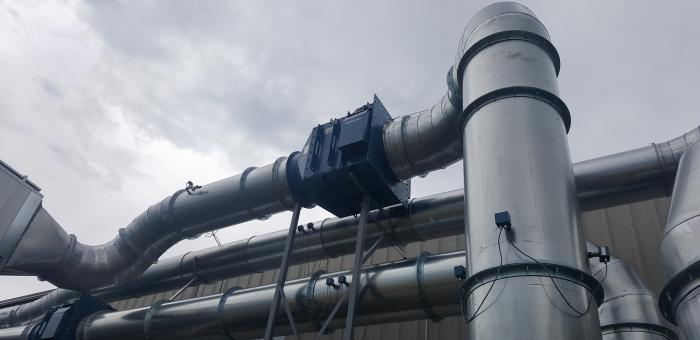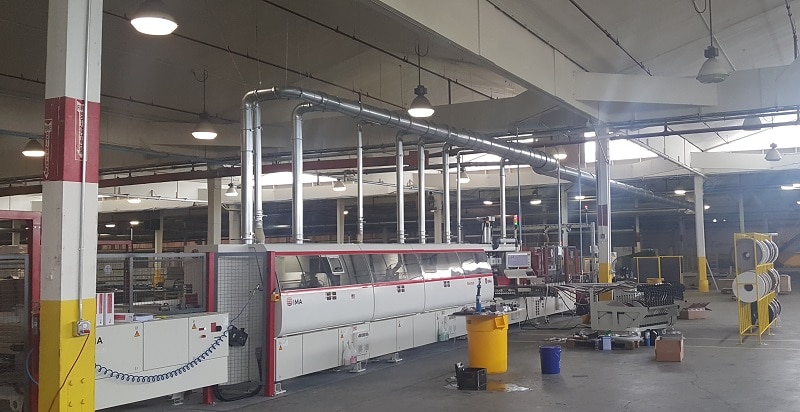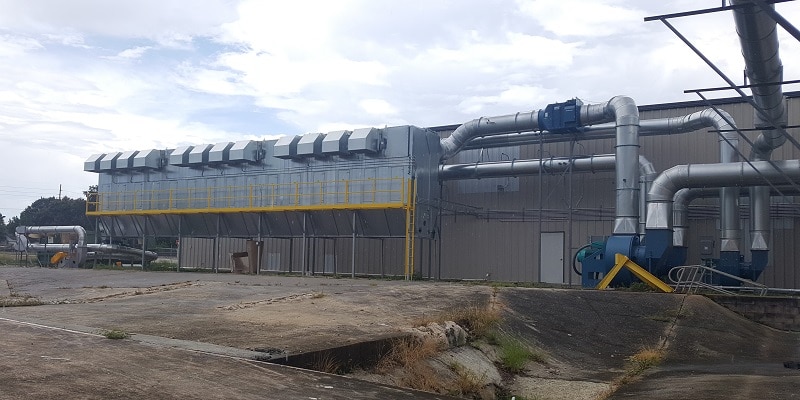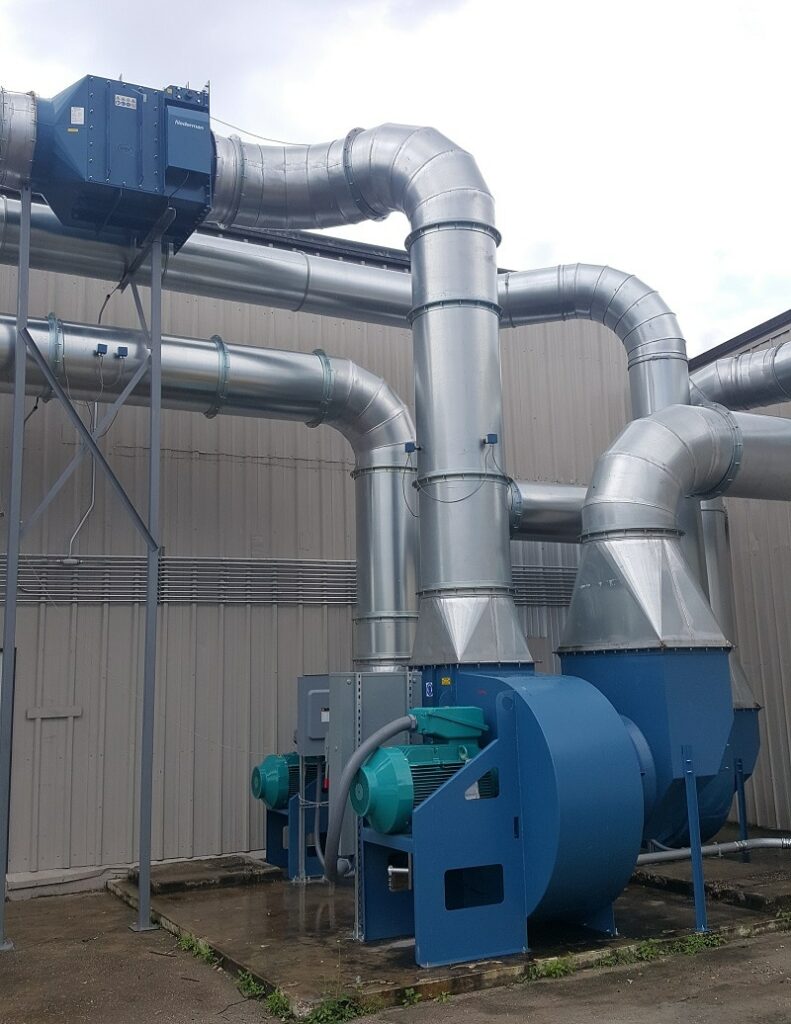High-Volume Dust Collection System Designed for Energy Efficiency

For Alvic’s first large high-volume panel production operation in the United States, the company worked with Nederman Corp. to comply with U.S. regulatory requirements and learned how facilities and infrastructure differed from Alvic’s main factories in Spain. Nederman U.S. and Spanish representatives visited Alvic’s main factory in Alcaudete, Spain.
Alvic USA is part of Grupo Alvic in Spain. In 2017 Alvic USA was founded to supply the North American market from Auburndale, Florida. They make MDF and particleboard component parts, with finishes of Synchron and lacquer, available as panels from 4 x 8 feet to a maximum size of 5 x 10, as well as parts that are edgebanded and drilled, explained Yves Lebovics of Alvic.
The Florida plant has 320,000 square feet of floor space with the capacity to add machinery to the existing production lines. Currently, there is one Wemhoener short-cycle press line, one Superfici lacquering line, one automated storage system, one Heesemann sanding line, and several Schelling saws. There are also three IMA edgebanders.

“When selecting Nederman as a partner the goal was to acquire a dust collection system which is known to be very reliable while finding the best ratio between price and performance, capable to be easily expanded in the future and (operated) separately for different production departments,” Lebovics said.
“Lead time was an extremely important part of the decision-making process as well and Nederman performed exactly what they promised. The dust collection system came with blast gates for each machine which allowed (us) to shut off dust collection by machine and in the meanwhile we even further developed the energy consumption reduction by automatically dialing down fan speeds when parts of the machines are not running or no parts are running through the machine for a specified period of time.”
The dust collector came with a Flamex system, connected to the facility’s sprinkler system which, in case of a fire, automatically shuts off the air flow in the extraction pipe and fights fire with the connected sprinkler system.
“The size of the system was chosen to cover the required CFM of the machines in the facility during the first stage of the production, and knowing it easily can be expanded was a significant advantage to minimize energy cost during day-by-day operation,” Lebovics said. “The system therefore did not need to be oversized for future needs and consume unnecessarily energy in the meantime.
“The Nederman process to clean bags during operation was imperative, especially since we have to deal with many different kinds of extractable waste, ranging from sanding dust to melamine paper chips to typical chip and dust particles. To date the dust collection system did not show any signs of problems dealing with this variety of materials.”
As far as the design and installation, Alvic USA only had to provide sufficient power to its designated location. Nederman covered the entire engineering, installation, startup, training, and annual preventative maintenance to assure everything is working correctly, Lebovics said.

Robert Williamson, vice president of technical solutions and business development, Nederman Corp., said that compliance with combustible dust safety standards and local codes was a challenge.
“With so much at stake, the system design must be able to pass the local building review process and Fire Marshall inspection,” he said. “(For) combustible dust safety, the system is designed to meet the NFPA Standard 664 which is considered by most Authorities Having Jurisdiction, AHJ, as the industry standard. Furthermore, Insurance Underwriters will look for these safety features to approve policies and set premiums.”
Collector location and pipe routing also required special attention.
“This is an existing facility with a sizable footprint and many compartments,” Williamson said. “We located the collector where the waste containers could be easily removed and where in case of a deflagration event the flame front would be directed into a restricted zone. Furthermore, we needed to dimension each zone to meet the extraction requirements and minimize the energy consumption. Some of the machinery zones were 100 feet from the location and the farthest were 300 feet away.”
Modern machinery requires higher capture speeds and hood vacuum pressures due to the cutting and feed speeds, Williamson said. Without providing the correct air flow and pressure, the function and quality of the process would be comprised.
Also, Alvic provides complex and high-quality finishes on their decorative process. The sanding and cleaning process generates extremely fine particles. The system was dimensioned to filter the dust-laden air at high efficiency rates and be able to regenerate the media within a defined pressure range so to not affect the extraction volume.
“For this size of facility and process complexity, off-the-shelf solutions do not exist,” Williamson said. “Our systems are modular so there is a great deal (of) flexibility in the design process and for expandability to handle future machinery. However, we custom configure the system based on the end user’s process. This includes considering how many shifts they operate for each department, machinery types, machinery utilization, amount of time processing material, (and) types and amount of waste. By matching the production process, the system is set up for lowest cost of ownership, (including) upfront investments, operating costs (energy consumption and waste disposal) and maintenance costs.
“The system is set up for phased installation of the equipment and can be expanded to handle future capacity. This was the installation site for our first CARZ-N Explosion Isolation Valve. We just released this new product series to meet the more stringent ATEX test protocols. We rented a quarry in Sweden to test these large diameter valves because many test companies could not handle the impact areas of the test explosions.”
According to Williamson, maximum extraction volume of the dust collection system is 70,000 SCFM.
The system features a reverse air cleaning system, NRS-10 ATEX compliant rotary valve discharge, and central control panel with PLC controller. Cleaned air is exhausted to the atmosphere.
There are three extraction zones. All zones can run independently or operate together. Also, variable frequency drives can dynamically change the airflow in each line. Zone 1 has extraction capacity of 15,500 SCFM, Zone 2 has extraction capacity of 27,000 SCFM, and Zone 3 has extraction capacity of 17,200 SCFM.
A Quickfit piping “clamp together” system connects wood processing machinery to system. Discharge arrangement consists of a closed loop pneumatic system to load a 40-yard container.
Safety components include a spark detection and extinguishment systems on the three extraction lines, explosion isolation flaps on three extraction lines. See https://www.nederman.com/en-us/industry-solutions/woodworking
Also see https://www.alvicusa.com/

Karl D. Forth is online editor for CCI Media. He also writes news and feature stories in FDMC Magazine, in addition to newsletters and custom publishing projects. He is also involved in event organization, and compiles the annual FDM 300 list of industry leaders. He can be reached at karl.forth@woodworkingnetwork.com